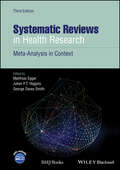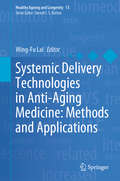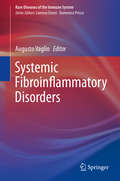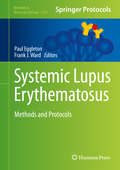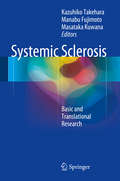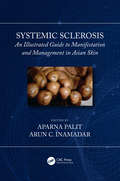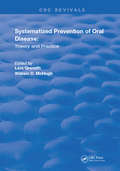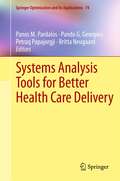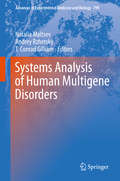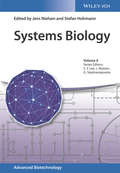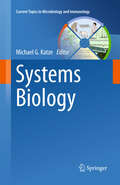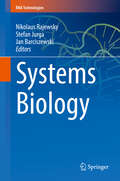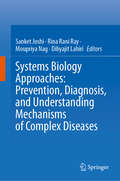- Table View
- List View
Systematic Psychiatric Evaluation: A Step-by-Step Guide to Applying The Perspectives of Psychiatry
by Margaret S. Chisolm Constantine G. LyketsosTwo Johns Hopkins psychiatrists explain the Perspectives approach to evaluating patients with psychiatric disorders.The Perspectives approach to psychiatry focuses on four aspects of psychiatric practice and research: disease, dimensional, behavior, and lifestory. In Systematic Psychiatric Evaluation, Drs. Margaret S. Chisolm and Constantine G. Lyketsos underscore the benefits of this approach, showing how it improves clinicians' abilities to evaluate, diagnose, and treat patients.Drs. Chisolm and Lyketsos use increasingly complex case histories to help the mental health provider evaluate patients demonstrating symptoms of bipolar disorder, psychosis, suicidal ideation, depression, eating disorders, and cutting, among other conditions. The book also includes an exercise that simulates the Perspectives approach side by side with traditional methods, revealing the advantages of a method that engages not one but four points of view. Featuring a foreword by Drs. Paul R. McHugh and Phillip R. Slavney, the originators of the Perspectives approach, this innovative book will be used in psychiatric training programs as well as by practicing mental health clinicians.
Systematic Reviews in Health Care
by Douglas Altman Matthias Egger George Davey-SmithThe second edition of this best-selling book has been thoroughly revised and expanded to reflect the significant changes and advances made in systematic reviewing. New features include discussion on the rationale, meta-analyses of prognostic and diagnostic studies and software, and the use of systematic reviews in practice.
Systematic Reviews in Health Research: Meta-Analysis in Context
by Matthias Egger George Davey Smith Julian P.T. HigginsSystematic Reviews in Health Research Explore the cutting-edge of systematic reviews in healthcare In this Third Edition of the classic Systematic Reviews textbook, now titled Systematic Reviews in Health Research, a team of distinguished researchers deliver a comprehensive and authoritative guide to the rapidly evolving area of systematic reviews and meta-analysis. The book demonstrates why systematic reviews—when conducted properly—provide the highest quality evidence on clinical and public health interventions and shows how they contribute to inference in many other contexts. The new edition reflects the broad role of systematic reviews, including: Twelve new chapters, covering additional study designs, methods and software, for example, on genetic association studies, prediction models, prevalence studies, network and dose-response meta-analysis Thorough update of 15 chapters focusing on systematic reviews of interventions Access to a companion website offering supplementary materials and practical exercises (www.systematic-reviews3.org) A key text for health researchers, Systematic Reviews in Health Research is also an indispensable resource for practitioners, students, and instructors in the health sciences needing to understand research synthesis.
Systematic Reviews to Support Evidence-Based Medicine: How to appraise, conduct and publish reviews
by Javier Zamora Khalid Saeed KhanAuthoritative, clear and concise, this highly acclaimed book continues to be an essential text for all medical, surgical and allied health professionals who are seeking a quick and respected guide to systematically reviewing the literature. The third edition features a new chapter on 'Publishing systematic reviews’ and numerous new case studies covering the latest developments in the field, including umbrella reviews, reviews of test accuracy, qualitative evidence and prognostic studies, and practice guidelines. The highly experienced authors, who have each contributed to numerous systematic reviews that have helped form policy and practice, ensure that this practical text, which avoids technical jargon, continues to be the reference of choice for all health professionals undertaking literature reviews, including those specializing in epidemiology and public health.
Systematic Treatment Selection: Toward Targeted Therapeutic Interventions
by Larry E. Beutler John F. ClarkinFirst published in 1990. Routledge is an imprint of Taylor & Francis, an informa company.
Systemic Delivery Technologies in Anti-Aging Medicine: Methods and Applications (Healthy Ageing and Longevity #13)
by Wing-Fu LaiThis book presents a multidisciplinary assessment of the state of science in the use of systemic delivery technologies to deliver anti-aging therapeutics now under development. There is a gap between basic aging research and the development of intervention technologies. This major obstacle must be overcome before biogerontological interventions can be put into clinical practice. As biogerontology comes to understand aging as a systemic degenerative process, it is clear that there is a pressing need for technologies that enable cells and tissues in a fully developed adult body to be manipulated systemically to combat aging. The authors review advances in the chemistry and engineering of systemic delivery methods and analyze the strengths and limitations of each.The book is organized into six sections. The first offers an overview of the need for systemic delivery technologies alongside the development of anti-aging therapies and describes approaches that will be required for studying the properties and efficiency of carriers for systemic delivery. Sections II, III and IV describe recent advances in a range of strategies that may enable systemic delivery to help combat aging conditions ranging from cell senescence to decline in immune function and hormonal secretion. Section V discusses practical strategies to engineer and optimize the performance of delivery technologies for applications in systemic delivery, along with their working principles. The final section discusses technical and biological barriers that must be overcome as systemic delivery technologies move from research laboratory to clinical applications aimed at tackling aging and age-associated diseases.Benefiting scholars, students and a broader audience of interested readers, the book includes helpful glossary sections in each chapter, as well as sidebars that highlight important notes, and questions for future research.
Systemic Disease Manifestations in the Foot, Ankle, and Lower Extremity
by Rock G. Positano Christopher DiGiovanni Jeffrey Borer Michael TrepalRecognize when lower extremity disorders signal a larger problem. Systemic Disease Manifestations in the Foot, Ankle, and Lower Extremity is the first clinical reference focused on helping you recognize when lower extremity symptoms indicate the presence of cardiovascular, neurologic, dermatologic, musculoskeletal, endocrinologic, infectious, or other systemic disorders. An impressive roster of multidisciplinary experts guides you through what to look for and how to confirm your diagnostic suspicions. The result is an indispensible resource that can facilitate early detection and timely treatment.
Systemic Disorders in Pregnancy: Management Principles
by Arvind Kumar Richa SharmaSystemic disorders in pregnancy is challenging in terms of diagnosis and management, as it compromises both mother and the baby. This book describes various maternal disorders along with their management algorithms and deals with exact standard operating procedures. It also includes periconceptional management, differential diagnosis, prevention, and latest guidelines and recommendations regarding medical disorders during pregnancy. This book provides helpful information to practicing obstetricians involved in the management of such patients and serves as a reference guide to students and residents in obstetrics and gynecology.
Systemic Fibroinflammatory Disorders
by Augusto VaglioThis book provides detailed information on the nosology, pathology, pathogenesis, clinical presentation, diagnosis and treatment of fibro-inflammatory disorders, rare diseases that often display systemic organ involvement. Among the conditions considered are IgG4-related disease, sclerosing cholangitis, Hashimoto's and Riedel's thyroiditis, retroperitoneal fibrosis/chronic periaortitis, mediastinal fibrosis, Erdheim-Chester disease, gadolinium-induced fibrosis, and sclerosing mesenteritis. This group of entities is still poorly defined and is characterized by the common denominator of chronic inflammatory infiltrate admixed with abundant fibrosis. IgG4-related disease is the prototypical example. Systemic Fibroinflammatory Disorders is the first book to draw together information on these conditions. As these diseases often require an interdisciplinary approach, the book is addressed to specialists of different disciplines, especially internists, rheumatologists, nephrologists, clinical immunologists, and hematologists.
Systemic Lupus Erythematosus
by Paul Eggleton Frank J. Ward"Systemic Lupus Erythematosus: Methods and Protocols" describe a number of genetic, biochemical and immunological techniques. These techniques provide an advancing understanding of the pathology, breakdown of the immune system and therapeutic challenges of SLE in both humans and animal models. Written in the highly successful "Methods in Molecular Biology" series format, chapters include introductions to their respective topics, lists of the necessary materials and reagents, step-by-step, readily reproducible laboratory protocols and key tips on troubleshooting and avoiding known pitfalls. Authoritative and practical, "Systemic Lupus Erythematosus: Methods and Protocols" appeal to biomedical and clinical scientists in a number of pathology disciplines at the doctoral and post-doctoral level.
Systemic Sclerosis
by Kazuhiko Takehara Manabu Fujimoto Masataka KuwanaThis book provides a comprehensive review of the recent advances in the research of systemic sclerosis (scleroderma). Systemic sclerosis is a complex autoimmune disease characterized by vasculopathy, fibrosis, and immune activation. This disease is also associated with certain susceptibility genes and is affected by epigenetic regulation. Recent studies have revealed a variety of new evidence suggestive of the pathogenesis of the disease. These include endothelial progenitor cells, cytokines and growth factors, and B cells. Studies using animal models have also provided novel insight into the pathomechanisms. In addition to these topics, the book covers clinical research regarding biomarkers and autoantibodies. This volume will benefit all rheumatologists and dermatologists as well as basic scientists, especially immunologists, molecular biologists, and biochemists.
Systemic Sclerosis: An Illustrated Guide to Manifestation and Management in Asian Skin
by Aparna Palit and Arun C. InamadarThis book presents a wide variety of cutaneous features of systemic sclerosis under one cover as cutaneous manifestations are often the first to appear and help in diagnosing this condition early. It has a multidisciplinary approach as systemic sclerosis is a multi-system disorder which comes under the purview of various medical specialties like dermatology, rheumatology and nephrology. Numerous cutaneous features are illustrated with explanatory notes. This book would help the students, teachers and professionals in identification, followed by subsequent treatment and management at an early stage. Key Features Focuses exclusively on systemic sclerosis Includes diagnostic tips Explores systemic sclerosis in dark skinned people Consists of key points at the end of each chapter Discusses diagnostic algorithms and flow charts
Systemic Vasculitides: Current Status and Perspectives
by Domenico Ribatti Franco Dammacco Angelo VaccaIn spite of their relatively low prevalence, systemic vasculitides have been the object of intensive basic and clinical investigations over the last few years. As a consequence, important advancements have been achieved: from updated diagnostic and classification criteria and a more rational nomenclature to the recognition of an expanding spectrum of clinical manifestations and potentially devastating complications; from the recognition of the viral etiology of conditions such as HCV-related cryoglobulinemic vasculitis and HBV-associated polyarteritis nodosa to newly named variable vessel vasculitis exemplified by Beh#65533;et's disease; from single-organ vasculitis such as central nervous system vasculitis to the more recently emerging features of the IgG4-related, immune-mediated diseases that are showing remarkable clinical heterogeneity. In addition, intriguing pathogenetic hypotheses are being reported for certain chronic, relapsing vasculitides that are improving our understanding of their biology and basic pathophysiology. New avenues are being explored that will hopefully allow a deeper comprehension of the relationships between certain virus-driven vasculitides and lymphoproliferation, and possibly lead to the identification of novel biomarkers that may be used to single out patients at an increased risk of relapse. This explosion of knowledge is obviously resulting in state-of-the-art, personalized treatments of systemic vasculitides. This book is a collection of reviews on the major vasculitides, written by scientists and clinicians with a multi-year experience in this field. We hope it will provide the reader with a stimulating container of new advances in scientific knowledge and more rational therapeutic approaches to this fascinating chapter of pathology.
Systemic Vasculitis
by M. Habib Bouhaouala Anthony W. Stanson Lotfi Hendaoui Francis JoffreThe prompt diagnosis of systemic vasculitis is essential as a missed diagnosis can be disastrous. Imaging is of vital importance in achieving a correct diagnosis and in some cases also plays a role in endovascular treatment. In this book, the imaging features of the many different types of vasculitis are clearly demonstrated by means of numerous high-quality illustrations. All relevant imaging modalities are considered, and key distinctive characteristics are highlighted. In addition, each chapter discusses the etiology, epidemiology, pathogenesis, clinical presentation, biology, and treatment of the vasculitis in question. This book is the result of cooperation between expert teams from a range of countries. The wealth of illustrations and informative clinical case studies will prove invaluable for all who may be confronted with these problematic disorders.
Systemisch-konstruktivistisches Clinical Reasoning: Im Präsenz- und Telesetting für Mediziner und Therapeuten (essentials)
by Andreas WolfsSystemisch-konstruktivistisch ausgedeutetes Clinical Reasoning bringt einen Mehrwert für die patientenorientierte Gestaltung von medizinischen, pflegerischen und therapeutischen Interventionen. Es bietet teilhabeorientierte Blickwinkel bei der Analyse von Interventionen als Störungen für die Patient*innen, Beziehungen und Interaktionen der Beteiligten von Behandlungssystemen sowie der Gestaltungen von Lehr- / Lernsituationen. Dabei kann es sowohl im Präsenz- als auch im Telesetting erfolgsversprechend als Grundlage der eigenen Reflexion eingesetzt werden.
Systemisch-konstruktivistisches Didaktisches Reasoning: Lernen im Behandlungsprozess mit Beispielen aus der Sprachtherapie (essentials)
by Andreas WolfsLernen ist ein zentraler Aspekt von Behandlungen in der Medizin, Pflege und Therapie. Der systemisch-konstruktivistische Blick auf die Gestaltung von Lehr-/Lernsituationen im Rahmen des didaktischen Reasonings ermöglicht relevante Erkenntnisse für die patienten- und teilhabeorientierte Gestaltung. Dieses essential stellt die Unterschiedlichkeit der Lehr-/Lernaktivitäten in sechs Handlungsebenen von drei Behandlungsphasen dar. Dabei bietet es eine Differenzierung zwischen bewusstem und unbewusstem didaktischen Reasoning sowie zwischen Tele- und Präsenzsetting. Zwei sprachtherapeutische Beispiele unterstützen den Übertrag in den eigenen beruflichen Alltag.
Systemisch-konstruktivistisches Interaktives Reasoning: Kommunikation und Beratung im Behandlungsprozess an Beispielen der Logopädie (essentials)
by Andreas WolfsIndividuelle und personenzentrierte Kommunikation ist essentieller Bestandteil jeder Behandlung in Medizin, Pflege und Therapie. In diesem essential werden die Aspekte des interaktiven Reasonings systemisch-konstruktivistisch ausgedeutet und im Kontext von sechs Handlungsebenen in drei Behandlungsphasen betrachtet. Begriffe wie Kontingenz, Anschlussfähigkeit und Perturbationstoleranz bieten dabei Möglichkeiten, eine teilhabeorientierte Kommunikation zu differenzieren. Zur Veranschaulichung der einzelnen Betrachtungsebenen unterstützen zwei sprachtherapeutische Beispiele und Ausführungen zum bewussten interaktiven Reasoning als Grundlage der Reflexion. Besonderes Augenmerk wird auf die behandlungsinduzierte Beratung als spezielle und relevante Form der Kommunikation gelegt.
Systemized Prevention of Oral Disease: Theory and Practice (Routledge Revivals)
by Lars Granath William D. McHughFirst published in 1986: This book presents a new approach to oral diseases. Recent decades have seen the proliferation of methods to prevent these diseases and enormous growth in the underlying scientific knowledge and mechanisms of prevention.
Systems Analysis Tools for Better Health Care Delivery
by Panos M. Pardalos Petraq Papajorgji Pando G. Georgiev Britta NeugaardThis book presents some recent systems engineering and mathematical tools for health care along with their real-world applications by health care practitioners and engineers. Advanced approaches, tools, and algorithms used in operating room scheduling and patient flow are covered. State-of-the-art results from applications of data mining, business process modeling, and simulation in healthcare, together with optimization methods, form the core of the volume. Systems Analysis Tools for Better Health Care Delivery illustrates the increased need of partnership between engineers and health care professionals. This book will benefit researchers and practitioners in health care delivery institutions, staff members and professionals of specialized hospital units, and lecturers and graduate students in engineering, applied mathematics, business administration and health care.
Systems Analysis of Chromatin-Related Protein Complexes in Cancer
by Andrew Emili Shoshana Wodak Jack GreenblattEpigenetic modifications underlie all aspects of human physiology, including stem cell renewal, formation of cell types and tissues. They also underlie environmental impacts on human health, including aging and diseases like cancer. Consequently, cracking the epigenetic "code" is considered a key challenge in biomedical research. Chromatin structure and function are modified by protein complexes, causing genes to be turned "on" or "off" and controlling other aspects of DNA function. Yet while there has been explosive growth in the epigenetics field, human chromatin-modifying machines have only recently started to be characterized. To meet this challenge, our book explores complementary experimental tracks, pursued by expert international research groups, aimed at the physical and functional characterization of the diverse repertoire of chromatin protein machines - namely, the "readers, writers and erasers" of epigenomic marks. These studies include the identification of RNA molecules and drugs that interact selectively with components of the chromatin machinery. What makes this book distinctive is its emphasis on the systematic exploration of chromatin protein complexes in the context of human development and disease networks.
Systems Analysis of Human Multigene Disorders
by Natalia Maltsev Andrey Rzhetsky T. Conrad GilliamUnderstanding the genetic architecture underlying complex multigene disorders is one of the major goals of human genetics in the upcoming decades. Advances in whole genome sequencing and the success of high throughput functional genomics allow supplementing conventional reductionist biology with systems-level approaches to human heredity and health as systems of interacting genetic, epigenetic, and environmental factors. This integrative approach holds the promise of unveiling yet unexplored levels of molecular organization and biological complexity. It may also hold the key to deciphering the multigene patterns of disease inheritance.
Systems Biology
by Jens Nielsen Gregory Stephanopoulos Sang Yup Lee J. Nielsen Stefan HohmannComprehensive coverage of the many different aspects of systems biology, resulting in an excellent overview of the experimental and computational approaches currently in use to study biological systems. Each chapter represents a valuable introduction to one specific branch of systems biology, while also including the current state of the art and pointers to future directions. Following different methods for the integrative analysis of omics data, the book goes on to describe techniques that allow for the direct quantification of carbon fluxes in large metabolic networks, including the use of 13C labelled substrates and genome-scale metabolic models. The latter is explained on the basis of the model organism Escherichia coli as well as the human metabolism. Subsequently, the authors deal with the application of such techniques to human health and cell factory engineering, with a focus on recent progress in building genome-scale models and regulatory networks. They highlight the importance of such information for specific biological processes, including the ageing of cells, the immune system and organogenesis. The book concludes with a summary of recent advances in genome editing, which have allowed for precise genetic modifications, even with the dynamic control of gene expression. This is part of the Advances Biotechnology series, covering all pertinent aspects of the field with each volume prepared by eminent scientists who are experts on the topic in question.
Systems Biology
by Michael G. KatzeFirst, systems biology is an inter-disciplinary approach, requiring the combined talents of biologists, mathematicians, and computer scientists. Second, systems biology is holistic, with the goal of obtaining a comprehensive understanding of the workings of biological systems. This is achieved through the acquisition of massive amounts of data by high-throughput technologies--oligonucleotide microarrays, mass spectrometry, and next-generation sequencing--and the analysis of this data through sophisticated mathematical algorithms. It is perhaps the use of mathematics, to integrate abundant and diverse types of data and to generate models of interconnected molecular networks, that best characterizes systems biology.
Systems Biology (Rna Technologies Ser.)
by Jan Barciszewski Stefan Jurga Nikolaus RajewskyMany breakthroughs in experimental devices, advanced software, as well as analytical methods for systems biology development have helped shape the way we study DNA, RNA and proteins, on the genomic, transcriptional, translational and posttranslational level. This book highlights the comprehensive topics that encompass systems biology with enormous progress in the development of genome sequencing, proteomic and metabolomic methods in designing and understanding biological systems.Topics covered in this book include fundamentals of modelling networks, circuits and pathways, spatial and multi cellular systems, image-driven systems biology, evolution, noise and decision-making in single cells, systems biology of disease and immunology, and personalized medicine. Special attention is paid to epigenomics, in particular environmental conditions that impact genetic background. The breadth of exciting new data towards discovering fundamental principles and direct application of epigenetics in agriculture is also described.The chapter “Deciphering the Universe of RNA Structures and Trans RNA-RNA Interactions of Transcriptomes in vivo - from Experimental Protocols to Computational Analyses” is available open access under a CC BY 4.0 license via link.springer.com.
Systems Biology Approaches: Prevention, Diagnosis, and Understanding Mechanisms of Complex Diseases
by Sanket Joshi Rina Rani Ray Moupriya Nag Dibyajit LahiriThis book examines the development and applications of system biology approaches for the prevention, diagnosis, and understanding of disease mechanisms. It explores the applications of system biology in infectious diseases, including host-pathogen interaction, and the identification of targets for new therapeutics and intervention strategies. It covers the use of system biology for understanding and treating metabolic disorders towards personalized and precision medicine. The book further discusses the systems biology approaches for understanding the mechanisms of tumor progression and designing more effective cancer therapies. The chapter also reviews the current strategies in autoimmune disease treatment and highlights the opportunity that systems biology represents for the development of better and safer treatments. Importantly, the book discusses the current state of the systems-level understanding of diseases and both the therapeutic and adverse mechanisms of drug actions usingsystem biology approaches. Cutting across the disciplines, this book is a valuable source for researchers in genetics, molecular biology, cell biology, microbiology, and biomedical sciences.


